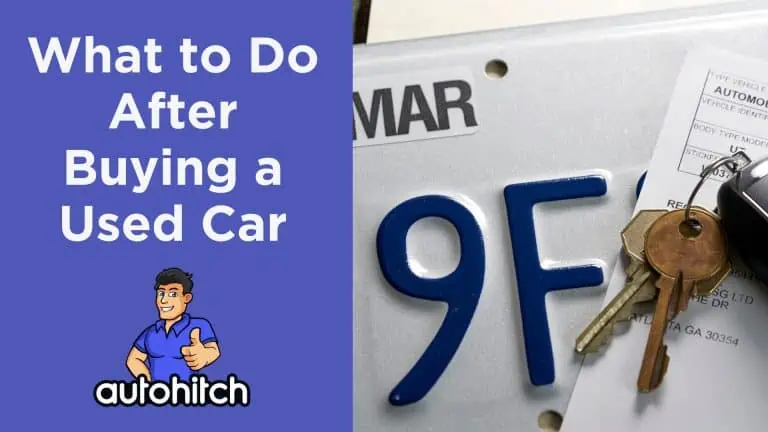Congratulations on your new purchase!
Buying a car, whether it be a new or used vehicle, is a significant milestone. However, the journey doesn’t end with the acquisition. There are several crucial steps to take after buying a used car, such as:
- Getting a license plate
- Paying Sales Tax
- Getting an emissions test (Certain states)
- And updating your insurance on time
Let’s address these and the different steps you might take when buying a used car from a dealership vs a private seller below.
Table of Contents
Part 1: Buying a Car from a Dealership
1. Insure Your Car
The first step after buying a car is to get it insured. It’s not only a legal requirement in most states but also protects you financially in case of accidents or theft. Shop around to get estimates from different auto insurance companies and decide how much coverage you want. If you financed your car, the lender might require you to get full coverage.
See also: What to do if the dealer sold you a bad car?
If you already have coverage, you might get a grace period of time between when you purchase the car and when you must update your insurance, but I suggest you don’t use it. Insurance companies are notorious for finding excuses NOT to pay out. Don’t get yourself caught in a bad spot, just update your insurance before you drive away!
2. Transfer the Title
When you purchase a used car from the dealership, most states require by law that they handle the transfer of title along with issuing you a temporary registration and temporary tags. If you paid for the car in full and did not finance, you will sign the title there and fill out the odometer information. The dealer will then send the title in for processing, and you should receive either a paper copy or a notification of an E-Title within 7-10 business days (In most states).
3. Register Your Vehicle
Again, if you purchased a car from a licensed dealer, they will be required to handle the registration for you. Should there be any problems, such as you not receiving your tag and registration on time or receiving them with incorrect information, the dealer is who you should contact (Not the DMV).
4. Schedule Maintenance
Whether you have a new car or a used car, it’s essential to schedule regular maintenance to keep it running smoothly, especially if you have any warranty coverage. Warranty companies will require not only that you keep up with scheduled maintenance but that the maintenance is documented. So, if you change your own oil, that doesn’t count.
Failing to follow the maintenance requirements spelled out in your warranty can and usually does result in your repairs not being covered!
Check with the dealership for a maintenance schedule, and follow it as closely as possible.
5. Save Your Paperwork
Keep all car-related paperwork on file. This includes your bill of sale, tax receipts, insurance certificate, financing documents, and an extra copy of your registration.
Part 2: Buying a Car from a Private Seller
1. Transfer the Title
Ensure that the title is transferred from the previous owner to you. That means that the person on the title is the person that signed it over to you. After the title has been filled out in full, you will need to take it to the local DMV or Tag Agency to complete the transfer.
Don’t worry; this is usually a lot more straightforward of a process than people think.
2. Register Your Car
After you’ve transferred the title, be sure to register the vehicle (You will probably be doing this at the same time you transfer your title).
Again, as long as you have all the documents your state requires, this is an easy process. It’s the people who forget something that ends up frustrated.
3. Get Auto Insurance
Most states require car insurance by law, and if you don’t have insurance, you won’t be allowed to register the vehicle.
Check your state’s requirements because each state’s minimum coverage requirements are different. I also recommend speaking with a licensed and experienced insurance agent about what coverage they recommend.
Believe me! You do not want to get caught being responsible for a serious accident someday and end up in bankruptcy over an extra $50 a month.
4. Get the Car Inspected and Plan for Maintenance
It’s always best to get a certified and trusted mechanic to thoroughly examine a car before buying it. If you’ve had a mechanic look at the car, then you’re set there, but if you didn’t, I suggest that be your very next step.
I purchased a vehicle one time that I looked up and down real well as a car dealer. Once my mechanic got it he discovered the shocks were almost shot, and the engine mounts were ready to go.
5. Research the Vehicle’s History
If you bought a used car, you should already have a vehicle history report, but if you don’t, go ahead and get one just to have it on file. This report can show you information such as previous maintenance, accidents, repairs, and more.
You can also check if the car has been recalled or has safety issues.
FAQ
Do I Need to Go to the DMV After Buying a Used Car?
If you purchased your car from a dealer, you do not need to go to the DMV. If you bought your car from a private seller, yes, you do need to go to the DMV.
However, some states offer online services that can save you a trip.
How Long Can I Drive Without a Registration After Buying a Car?
Driving without registration is illegal, and the grace period (assuming your state has one) varies. The best thing to do is just go ahead and knock it. If you’re concerned about being inconvenienced, then getting pulled over isn’t going to help!
What Should I Do After I Buy a Car from a Private Seller?
When buying from a private seller, you’ll need to handle the title transfer, registration, and insurance yourself. It’s also a good idea to get the car inspected by a trusted mechanic before finalizing the purchase because you really have NO IDEA what you might have missed.
Checklist for Buying a Used Car from a Private Seller
A detailed checklist can guide you through the process of buying a used car from a private seller. This includes verifying the condition of the car, checking the vehicle’s history, and ensuring all necessary paperwork is in order.
When I Buy a Car from a Private Seller, Can I Drive It Home?
Yes, you can drive the car home after purchase. However, ensure you have insurance coverage and understand your state’s requirements regarding title transfer, registration, and the grace period you have to get everything completed.
Conclusion
In conclusion, the process of buying a used car doesn’t end with the purchase itself. Whether you’re buying from a dealership or a private seller, there are essential steps to follow to ensure a smooth transition of ownership and compliance with the law.
These steps include securing auto insurance, transferring the title, registering the vehicle, and scheduling regular maintenance. It’s also crucial to keep all car-related documents and understand your state’s specific requirements.
By following these guidelines, you can enjoy your new purchase with peace of mind, knowing that you’ve taken the necessary measures to protect your investment and stay within the law.



